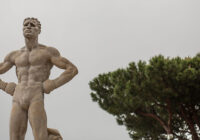Horia Sima, a central figure within the interwar Romanian fascist organization the Iron Guard, once described his leader, Corneliu Codreanu, as follows:
“What was most impressive, on first contact with Codreanu, was his physical appearance. Nobody could pass him by without noticing him, without being attracted by his look, without asking who he was. His public appearance provoked curiosity. This young man seemed a god descended among mortals … Looking at him, you felt dazed. His face exercised an irresistible fascination. He was a ‘living manifesto’, as the Legionaries used to call him.”
Such a description, highlighting an emotive, passionate and even irrational bond between a fascist and his leader, is a typical expression of the charismatic leader dynamic. Though this is an important phenomenon to consider, it can also sometimes be rather lazily used as an essential component of the far right and needs to be used with care.
German Nationalism, From Revolution to Illiberalism
When surveying the emergence of terms such as charisma, charismatic leadership and so forth, it is impossible not to start with the founding sociologist Max Weber. He argued that political legitimacy came in three varieties: traditional, legal bureaucratic and charismatic. Traditional authority operates through customs providing validity to a leader’s decisions, such as with a monarchy; legal bureaucratic works through an impersonal system of rules providing authority, such as within a liberal democracy; and charisma, meaning “gift of grace,” sees authority emanating from the extraordinary nature of a leader, as understood by followers. For Sima, Codreanu clearly evoked the latter.
Weber added some further nuances to his concept as well. In particular, he wrote of the sense of mission that a charismatic leader evokes, a cause shared by his or her followers, giving their charisma a sense of purpose. For those who do not share this mission, such leaders are unlikely to hold much charismatic appeal. The leader generates their sense of having special qualities by, effectively, becoming a living embodiment of a passionately held cause. They do this as they, somehow or other, go beyond that of others who share the same sense of mission.
Charismatic bonds between leader and follower are not created by a leader alone but are a phenomenon that emerges from the shared, affective dimension between leaders and followers. As Ann Ruth Willner puts it: “[C]harisma is defined in terms of people’s perceptions of and responses to a leader. It is not what the leader is but what people see the leader as that counts in generating the charismatic relationship.”
The Duce
Charisma has been a term applied to many fascist leaders. Emilio Gentile, writing in Modern Italy in 1998, uses Weber’s approach to examine Benito Mussolini’s charisma as emanating from his political mission. He concludes that the Duce experienced periods of greater and lesser charismatic appeal: Firstly as a socialist leader before the First World War, then as a leader of a new radical nationalist movement urging Italy to enter the war, and then once again his charisma grew during the rise of the fascist movement in Italy. Charisma was not a constant, but something that could grow and wane.
Of course, Adolf Hitler’s Third Reich has been a particular focus for charismatic leadership. John Breuilly, writing in Nations and Nationalism in 2011, states that charismatic leadership was not typical of all nationalist movements, but was common in fascists such as Codreanu, Mussolini and particularly Hitler. The interwar German conditions were unique. As he explains, in modern-day contexts, “it is the product of massive breakdowns of impersonal forms of modern authority that opens up a particular space, although there has to be someone capable of filling that space and, in Hitler’s case, a unique sequence of events leading to charismatic power.”
Aristotle Kallis, writing in Totalitarian Movements and Political Religions in 2006, also critically engages with Weber’s model and explains the need to differentiate between the leadership cults of movements and regimes, and their ability to foster of a genuine charismatic community. The former did not guarantee the latter, and an authentic charismatic community was only partially developed even in the Third Reich. Even here, Kallis stresses that Weber’s other forms of authority — traditional and legal — continued to hold some influence.
Roger Eatwell developed another influential analysis of fascist charismatic leadership, building critically on Weber’s model. Writing in The Oxford Handbook of the Radical Right in 2018, he argues that as well as mission and personal presence, charismatic leaders promote a Manichean division of the world to help legitimize their emotive bonds with followers. Moreover, he stresses the need to consider the role of charismatic leadership at the level of the coterie, focusing on how the phenomenon helps bind together radical political groups.
The question regarding the continued importance of charismatic leadership in more recent populist parties has also been much discussed. Duncan McDonnell published an essay in Political Studies that explores charisma at the level of the coterie, focusing on perceptions of charisma amongst populist party members, both elected officials as well as grassroots activists. His approach urges care in applying the term, while by examining interviews with party coteries, he helpfully exemplifies how charisma needs to be studied through assessing the interactions between leaders and followers. As well as concluding that Italy’s Silvio Berlusconi and Switzerland’s Christoph Blocher were partial charismatic leaders, he concludes that Umberto Bossi was an archetypal charismatic leader of the Northern League — yet this meant his downfall caused the Italian party much damage as a consequence.
Whether charismatic leadership is an essential component of populism has also been debated. Takis S. Pappas, writing in the Routledge International Handbook of Charisma, states that “populism and charismatic leadership are inescapably interrelated and should always be studied conjoinedly.” Contrastingly, in The Oxford Handbook of Political Leadership, Cas Mudde and Rovira Kaltwasse stress that populism is a complex, variegated phenomenon with many forms of leadership; charismatic leaders are one among various styles among populists, which can even include no leader at all. The latter point seems to echo the cautionary use of the term among historians of fascism. Notably, Roger Griffin resisted using charisma as a defining aspect of fascism in his influential model of the ideology.
The Short Shelf Life of Charisma
Nevertheless, some of the most striking figures in recent years in the far right have been charismatic in their style. Donald Trump, the former US president, powerfully unleashed a form of charismatic leadership as he generated an affective bond between himself as a leader and a wider following through a shared sense of mission. However, even this mission does have a shelf life and will not last forever, as his election defeat in 2020 suggests.
I wrote a short article for The Guardian in 2019 reflecting on Trump as a charismatic leader and predicted a decline in his charismatic appeal over time. Some waning of his charisma has clearly occurred since then, although the study of charisma shows us the phenomenon can ebb and flow. Trump, after all, retains great influence within the Republican Party and continues to enjoy a widespread aura of infallibility among a largescale movement that supports his mission and sees him in emotive, superlative ways.
As a historian, I leave it to others to predict where this may go in the next few years, but more widely, the relationship between the populist and fascist right and charismatic leaders is both complex and ongoing. For those studying this in the coming years, it is important to focus on the limits of the charisma model as well as its strengths, and it is unhelpful if used to try to explain everything. It is also crucial to consider how people project onto leaders a perception of them as charismatic. After all, charisma does not come from a leader alone — it is projected onto him or her by others. Without this atmosphere, such leaders often have little else to offer.
*[Fair Observer is a media partner of the Centre for Analysis of the Radical Right.]
The views expressed in this article are the author’s own and do not necessarily reflect Fair Observer’s editorial policy.
Support Fair Observer
We rely on your support for our independence, diversity and quality.
For more than 10 years, Fair Observer has been free, fair and independent. No billionaire owns us, no advertisers control us. We are a reader-supported nonprofit. Unlike many other publications, we keep our content free for readers regardless of where they live or whether they can afford to pay. We have no paywalls and no ads.
In the post-truth era of fake news, echo chambers and filter bubbles, we publish a plurality of perspectives from around the world. Anyone can publish with us, but everyone goes through a rigorous editorial process. So, you get fact-checked, well-reasoned content instead of noise.
We publish 2,500+ voices from 90+ countries. We also conduct education and training programs
on subjects ranging from digital media and journalism to writing and critical thinking. This
doesn’t come cheap. Servers, editors, trainers and web developers cost
money.
Please consider supporting us on a regular basis as a recurring donor or a
sustaining member.
Will you support FO’s journalism?
We rely on your support for our independence, diversity and quality.






